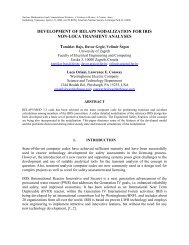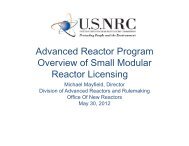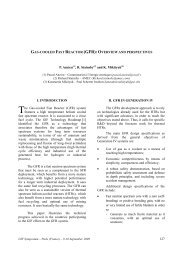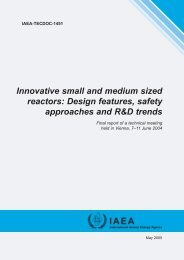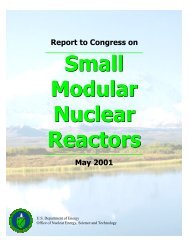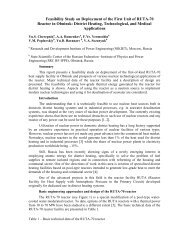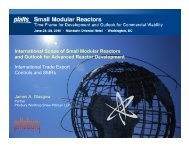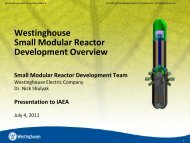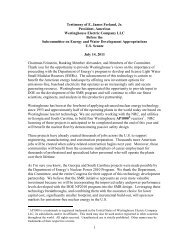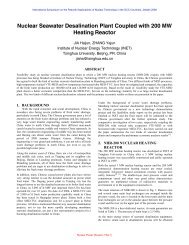Economic and Employment Impacts of Small Modular Reactors - SMR
Economic and Employment Impacts of Small Modular Reactors - SMR
Economic and Employment Impacts of Small Modular Reactors - SMR
- No tags were found...
You also want an ePaper? Increase the reach of your titles
YUMPU automatically turns print PDFs into web optimized ePapers that Google loves.
oil. While most hydrogen is produced via steam reforming <strong>of</strong> hydrocarbons, it can be produced via<br />
electrolysis <strong>and</strong> high temperature chemical reactions, methods that can produce no greenhouse gas<br />
emissions. Conventional reactors, both large <strong>and</strong> <strong>of</strong> the <strong>SMR</strong> variety, can provide electricity for<br />
electrolysis. High temperature reactors that are capable <strong>of</strong> providing high temperature process heat for<br />
electrolytic, thermochemical, hybrid, <strong>and</strong> other applications are under development through the<br />
ant program. <strong>SMR</strong>s, based on gas-cooled<br />
or pebble-‐bed designs, could be used for hydrogen production in the future.<br />
Approach to <strong>SMR</strong> Market Potential<br />
While the potential uses <strong>and</strong> benefits <strong>of</strong> <strong>SMR</strong>s outlined above are numerous but certainly not all-inclusive,<br />
this study incorporates only the market potential for electricity production, using forecasts<br />
from established agencies <strong>and</strong> organizations. At present, electricity is the largest <strong>and</strong> most well-‐defined<br />
<strong>of</strong> the potential <strong>SMR</strong> applications. The cogeneration markets are ignored in this forecast for two<br />
reasons. First, the market size for these applications is anticipated to be significantly smaller than the<br />
electricity generation market. Second, the degree <strong>of</strong> uncertainty in estimating future cogeneration<br />
markets is significant <strong>and</strong> would taint the overall dem<strong>and</strong> forecasts <strong>of</strong> nuclear electricity generation<br />
from the reputable sources used for this study. Because <strong>of</strong> the omission <strong>of</strong> markets other than electricity<br />
generation, thforecasts for <strong>SMR</strong> dem<strong>and</strong> should be viewed as conservative in nature.<br />
Aside from the potential high temperature applications noted above, this study makes no assumptions<br />
about which <strong>of</strong> the <strong>SMR</strong> technologies currently under development will be deployed for different uses<br />
or at different locations. The fact remains that no <strong>SMR</strong>s have yet been certified by the NRC <strong>and</strong> the<br />
earliest this is expected to happen is 2015. Therefore the technical <strong>and</strong> financial performance <strong>of</strong><br />
different <strong>SMR</strong> designs has not yet been proved <strong>and</strong> the differing strengths <strong>and</strong> weaknesses <strong>of</strong> these<br />
designs cannot be currently evaluated. Under these circumstances, it is difficult to determine the<br />
market potential that exists for each design. As a result, a MW <strong>SMR</strong> will be assumed<br />
for the market potential <strong>and</strong> resulting economic analysis below.<br />
Section 3: <strong>SMR</strong> Market Potential<br />
The purpose <strong>of</strong> determining the market potential is to enable an economic impact analysis <strong>of</strong> small<br />
modular reactor manufacturing <strong>and</strong> operations in the U.S. over the next 20 years. This is achieved by<br />
first estimating the number <strong>of</strong> <strong>SMR</strong>s manufactured in the U.S., <strong>and</strong> second by estimating the number <strong>of</strong><br />
these reactors operating in the U.S. during this time period.<br />
This report presents four distinct cases projecting the potential economic impact <strong>of</strong> <strong>SMR</strong> systems<br />
through 2030. These cases are referred to as Low, Moderate, High, <strong>and</strong> Disruptive. Each case<br />
incorporates added nuclear power capacity for electricity production, the market share <strong>of</strong> <strong>SMR</strong>s for that<br />
capacity, <strong>and</strong> penetration <strong>of</strong> U.S. manufacturers into the overall global <strong>SMR</strong> market.<br />
14



